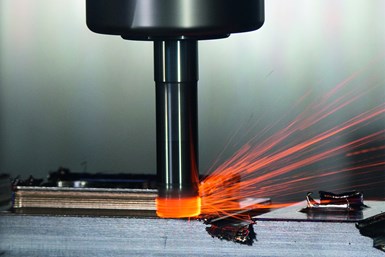Emuge-Franken End Mills Provide Optimized Vibration Dampening
Cera-Cut end mills are designed to produce high metal removal rates in challenging nickel-based alloys.
Share




Emuge-Franken USA has introduced its Cera-Cut end mills, which feature a high-hardness cutting ceramic head brazed to a carbide shank that is said to provide optimal vibration dampening and longer tool life compared to one-piece ceramic tools. Featuring a high-feed duplex cutting-edge geometry, Cera-Cut produces high metal removal rates in challenging nickel-based alloys, reportedly resulting in machining parts 200 to 400% faster than conventional carbide end mills. The tool life of Cera-Cut is up to five times higher than regular carbide end mills, according to the company.
Emuge-Franken Cera-Cut end mills are designed for the consistent cutting of high-temperature resistant materials such as Inconel, Hastelloy and Nimonic, as well as the machining of hardened tool steels. Cera-Cut is also suitable for making interrupted cuts, and offers a cutting-diameter tolerance ranging from -0.0008" to -0.0016" (-20 to -40 µm), depending on the tool diameter.
Cera-Cut end mills can be used for roughing or pre-finishing, and can produce 2D or 3D contours, and are suitable for face milling, slot milling, helical milling, contour milling and pocket milling. Emuge-Franken Cera-Cut End Mills are offered in different diameters from 0.24" to 0.79" (6 to 20 mm). Corner radius, modular and special designs are also available.
“With the growing use of heat resistant super alloys, we are pleased to offer our customers new, long-lasting five-flute ceramic end mills for roughing and milling in these challenging applications,” says Dan Doiron, manager of milling products at Emuge-Franken USA. Doiron adds that Cera-Cut excels in the machining of complex aerospace parts.
Related Content
-
The Impact of Cutting Teeth Spacing on Machining Stability
Many cutter designs are available, and variable teeth spacing (or variable pitch) cutters can be used to influence milling stability. Let’s discuss why teeth spacing affects stability.
-
Quick-Change Tool Heads Reduce Setup on Swiss-Type Turning Centers
This new quick-change tooling system enables shops to get more production from their Swiss turning centers through reduced tool setup time and matches the performance of a solid tool.
-
High-Feed Machining Dominates Cutting Tool Event
At its New Product Rollout, Ingersoll showcased a number of options for high-feed machining, demonstrating the strategy’s growing footprint in the industry.
.png;maxWidth=970;quality=90)


















.png;maxWidth=300;quality=90)



